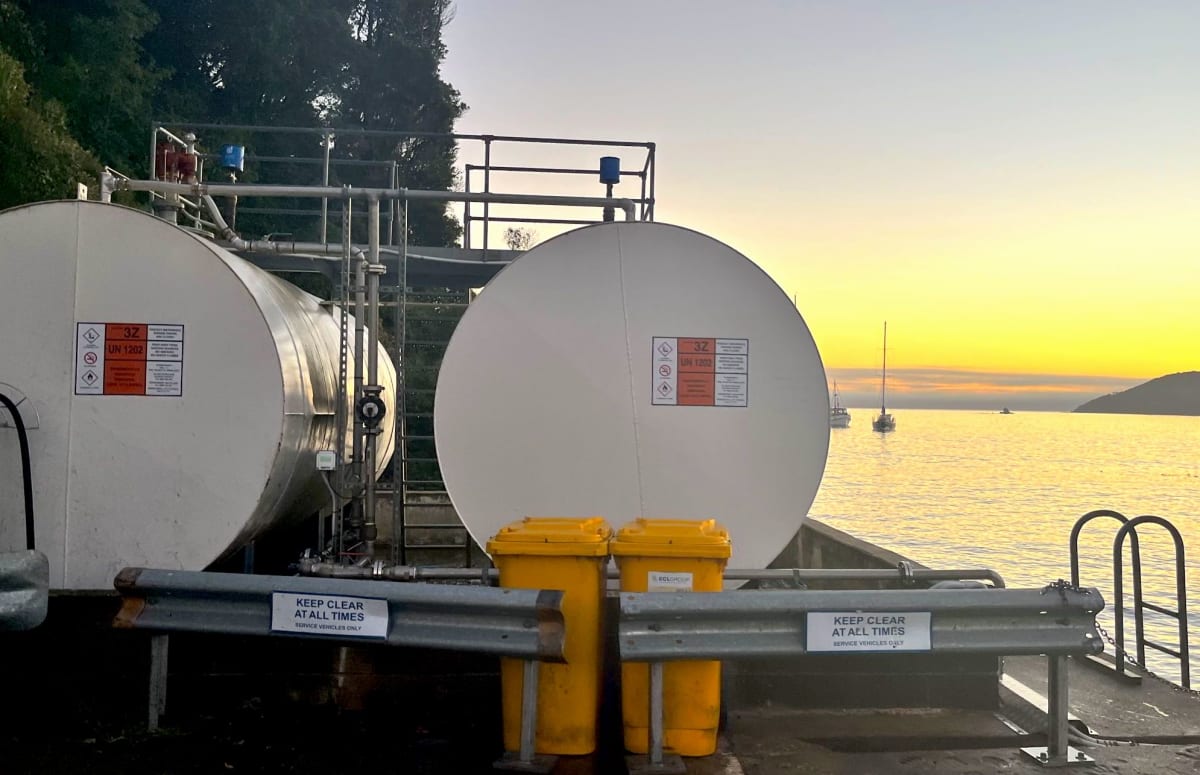
Keeping the lights burning on the country’s third-biggest island continues to consume diesel by the hundreds of thousands of litres a year despite the fuel’s rising cost at the pump and the ongoing damage it does to the environment.
Despite soaring fuel prices, carbon emissions and the risk of environmental disaster through spillage, Rakiura-Stewart Island looks set to remain reliant on diesel for its electricity. Unless, that is, local and central government can agree on a viable clean-energy alternative.
Last year, 360,000 litres or about $1.4 million of diesel was shipped across Foveaux Strait to bring power to the island’s people.
Rakiura-Stewart Island residents pay about three times more for their fossil-fuel-generated power than mainlanders. And that cost is set to keep rising with New Zealand’s average diesel price climbing 30.16 cents in the past month.
Southland District Council Mayor Gary Tong and Invercargill MP Penny Simmonds agree that the best long-term answer for the island is a cable across the strait. But Energy Minister Megan Woods, who holds the purse strings, says wind energy is still the most economical and technically doable option for the island’s large-scale decarbonisation.
Residents are sick of waiting for a solution after decades of renewable-energy feasibility studies and a year on from the canning of a Government Provincial Growth Fund (PGF) paid-for proposal for a $3.16 million wind farm.
Poles apart
Diesel generation delivers a monthly power bill for Stewart Island Backpackers of up to $4000 a month, and after running the place for five and half years, owners Aaron and Carol Joy are considering shuttering it for the winter.
Aaron Joy figures it is probably more economical to remain empty because of the electricity price coupled with subdued business as a result of Omicron.
He is frustrated by what he sees as local government indecision and feels ending the island’s diesel reliance feels like “one step forward and two steps back”.

Pete Bayne, owner of Stewart Island Electric Bikes, a thriving hire business, is acutely aware using diesel-generated electricity to charge his e-bikes doesn’t “fit the ethos” of his operation.
Solar panels provide power to run lights and a modem in his bike shed and there is “a little bit” left over to charge a couple of e-bikes. But most of what the business uses is diesel-generated.
Bayne thinks solar could provide a partial answer for the island, but he was supportive of the proposed wind farm and was disappointed when the idea fell by the wayside.
“It’s very disappointing that we haven’t got a solution, from what I understand, on the horizon to overcome our dependence on diesel.”
Greater good
Like most people who live on the island, Bayne has become "very frugal” at home, using gas and wood for cooking or heating and electricity mainly for lighting. Others on the island still use coal, although to a declining extent.
Bayne believes the island needs to work together for a solution.
“As things get more and more expensive, we are more motivated to use less and less and to go off-grid … that is counterproductive to maintaining a low price. If we all start looking after ourselves, the greater good suffers.”
Cafe and spa owner Britt Moore says tourists, who come to the island to enjoy the “eco-village” experience, are horrified when they discover the electricity they are using is diesel-generated.
Moore questions why the Government can’t fund or contribute to a cable across the strait when it gave $10 million to Niue to develop solar energy and to help the island-nation reach renewable energy targets.
“Yeah, it is going to cost money, but hasn’t the Government funded renewable energy on Niue? How can it pay for it there and not on Stewart Island? To me, it’s unbelievable.”
Moore says in a worst-case scenario, the island could be left diesel-less due “to a possible fuel energy collapse” caused by Russia’s invasion of Ukraine.

Rakiura-Stewart Island ward councillor Bruce Ford was one of the people responsible for getting the island’s existing power station funded and built in 1988, ending dependence on noisy, small household diesel generators.
But he says that was only meant to be temporary and renewable energy was always the long-term goal.
Ford says a community of 400 can’t afford to fund its own renewable energy projects, and he worries that if more homeowners, businesses or Government agencies go off-grid, the existing power station will become unsustainable.
Mists of time
Attempts to cut reliance on diesel are not new and failure to solve the issue hasn’t been due to lack of trying.
In 1946, a hydro scheme was considered, but rough terrain and cost sank the idea. More than 20-something studies, workshops, meetings and pub discussions have followed.
A cable across Foveaux Strait was first mooted in the 1970s, but it, too, sank due to cost.
In the 1990s, a Norwegian company visited with the promise of wave energy as the saviour for the island’s electricity woes. But estimates of the available energy were found to be grossly exaggerated so the idea stagnated, only to be revisited in 2011 and briefly in 2012, before again being abandoned.
Since the early 2000s, wind and solar energy have been the main focus.
The most recent proposal, announced in 2019 but deemed last year to be unworkable, would have seen the construction of two wind turbines that would have cut diesel-generation by 40 percent.
Two sufficiently windy sites were identified, but they were ruled out because of land accessibility, likely resource-consent opposition and safety concerns.
That was “probably the closest they have come” to reducing their fossil-fuel habit, says Ford.
He was initially disappointed that the wind turbines never got across the line, but having previously held a pilot licence, he understands how wind turbines probably weren’t best located near an airport, the preferred site.
Energy buffet
To save on cost, Ford and his wife Sue, like most islanders, combine the use of LPG, gas and wood to limit their power consumption, and on the day I visit, lamb shanks are simmering on the coal range in their kitchen.
Sue, originally from England, says her family back home are incredulous that the island still uses diesel to generate the bulk of its electricity.
“They can’t believe it. They say, ‘Where are your solar panels? Where is your wind farm? We thought you were all greenies down there.’”
And she agrees it is incongruous to be living on the edge of a national park that attracts people from around the world as the local power plant guzzles diesel.

Political prevarication
Mayor Tong is surprised Minister Woods still thinks wind turbines are the solution. “I’m sorry, Minister, that has been talked to death.
“For her still to be holding on to that confuses me. I would like to talk to her and maybe put her straight on that.”
Tong says everything possible was done to find another turbine location after the preferred sites struck community opposition.
Land at Ryan’s Creek Aerodrome was identified as the best site but it came down to the “nitty-gritty” in the end, he says. The Civil Aviation Authority probably would have nixed it and pilots were not keen to fly near the turbines.
The second-best option was Mamaku Point Conservation Reserve, home to the oldest podocarp forest in the country and 128 native species, including 26 native bird species.
It was “a last-resort site” and ruled out because the turbine project posed a risk to the reserve's predator-free status, says Tong.
His is convinced a direct-current cable across Foveaux Strait is the best option, and the Government should pay for it. But whether or not that will happen, he says, comes down to “the dirty old dollar at the end of the day”.
He is concerned about the effect of high power costs on existing island businesses and the impediment that poses for future commercial development. But worse is the potential for an environmental disaster.
“We have a piece of paradise, and we have a boat that picks up diesel at Bluff and takes it across Foveaux Strait, unloads it onto the wharf into a storage tank, then a truck that takes it up to the power station where it is unloaded into another storage facility and used.
“The environmental error that could occur is huge - I’m not talking about a few hundred litres of diesel here, but thousands.”
Minister big on wind
Woods would have liked to have seen the Government’s wind-farm plan, stymied “by the affected landowners”, go ahead. She says a cable would have to be subject to a “thorough engineering study” and could cost up to 10 times as much as wind.
“Any such project calling for significant public funding would need to contend with the many other compelling and worthy calls for Government support.”
A business case for wind generation to replace diesel is being developed for the Chatham Islands and could provide a useful model for Stewart Island, she says.
The local National Party MP, Penny Simmonds, is disappointed that neither PGF nor Covid-relief spending has found its way to a cable project, “particularly given the tourism growth Stewart Island has experienced”.
She acknowledges that National has not yet developed its own policy on power provision for the island and says if it got into government at the next election it might not have the “luxury” of funding as many worthwhile projects as it would like to.
Solar power learnings
Sails Ashore Lodge owners Peter and Iris Tait, meantime, have spent up large on solar panels and batteries at their boutique Oban accommodation. In March, they went off-grid, eliminating their on-average $900-a-month energy bills.
It feels good to be doing the right thing environmentally, says Peter Tait.
Solar power on their scale is unaffordable for most islanders, says Iris Tait, but her advice is to start small with a few panels and build from there.

The most visible solar set-up on the island is at Halfmoon Bay School. A $50,000 Ministry of Education grant paid for the installation of 60 solar panels and battery storage last year, in the expectation that it would save the school $8000 a year. Any solar surplus is being donated to the island’s power station.
For Ford, the mantra is “never ever give up”, as he sets his sights on bringing widespread solar to the island. His latest idea is to build a solar farm on council-owned land beside the existing power plant on Hicks Rd.
He has contacted a UK company to see if it is plausible and is waiting for a response. Watch this space.
Made with the support of the Public Interest Journalism Fund








